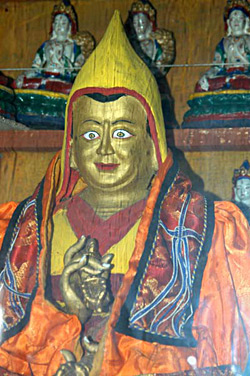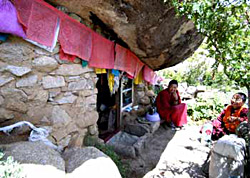by José Ignacio Cabezón and THL.
History

A statue of Khardo Zöpa GyatsoMkhar rdo bzod pa rgya mtsho preserved at Rakhadrak Hermitage (Rakhadrak RitröRa kha brag ri khrod).
Khardo Hermitage was founded in 17068 by Khardo Zöpa GyatsoMkhar rdo bzod pa rgya mtsho,9 a student of Drupkhang Gelek GyatsoSgrub khang dge legs rgya mtsho (1641-1713).10 Zöpa GyatsoBzod pa rgya mtsho entered the Jé College (Dratsang JéGrwa tshang byes) of SeraSe ra at age nine, and studied intensively for the next six years. When he was fifteen he asked permission to pursue intensive retreat. His teacher was agreeable, and he began to travel in Southern Tibet, visiting various holy sites, and remaining in isolated retreat in various locations for the next five years of his life. He returned to SeraSe ra when he was twenty, and it was at this time that he met the charismatic DrupkhangpaSgrub khang pa, who was giving teachings on the graded stages of the path (lamrimlam rim) at his hermitage above SeraSe ra. After this cycle of teachings was over (around the time that Zöpa GyatsoBzod pa rgya mtsho was twenty-four years old), he decided to go into more permanent retreat and, as the result of certain visionary signs, chose a cave at KhardoMkhar rdo as his home.
Zöpa GyatsoBzod pa rgya mtsho initially lived as a hermit in caves at KhardoMkhar rdo. Certain events,11 however, brought him to the attention of the Seventh Dalai Lama, who then requested KhardowaMkhar rdo ba to become his assistant tutor (tsenzhapmtshan zhabs). From this time forward, the Dalai LamaDa lai bla ma acted as KhardowaMkhar rdo ba’s patron and it was as a result of the Dalai LamaDa lai bla ma’s financial assistance that the first temple (Temple of the Sixteen Arhats) was built at KhardoMkhar rdo. Shortly after this temple was completed, the Seventh Dalai Lama provided the funds for the construction of a residence at the site, which he used when he went to KhardoMkhar rdo to visit his teacher. This building is what came to be known as the Upper Residence (see above). The Seventh Dalai Lama is also credited with having sponsored the construction of the first buildings in what later became the main compound. It was upon the completion of this latter project that he gave permission for eight fully ordained monks to live at the site. He also provided the hermitage with one small estate in the Dodé Valley for its support.

Detail of a painting of the Seventh Dalai Lama in the collection of the Rubin Museum of Art, from the www.himalayanart.org website, no. 212.
After the death of Zöpa GyatsoBzod pa rgya mtsho, the Seventh Dalai Lama performed all of the necessary funerary rites for his teacher, and sponsored the construction of his funerary stūpa and of his statue. (This existed at Khardo Hermitage until 1959.) The Dalai LamaDa lai bla ma also undertook the search for his teacher’s reincarnation, whom he found in Penpo’Phan po, not far from LhasaLha sa. Just as with Zöpa GyatsoBzod pa rgya mtsho and the Seventh Dalai Lama, a teacher-student relationship was established between the second Khardo LamaMkhar rdo bla ma and the Eighth Dalai Lama Jampel Gyatso (Dalai Lama Kutreng Gyepa Jampel GyatsoDa lai bla ma sku phreng brgyad pa ’jam dpal rgya mtsho). The second Khardo RinpochéMkhar rdo rin po che travelled extensively in northern Tibet, and he founded at least two monasteries in NakchuNag chu which then became satellite monasteries of Khardo Hermitage.12 This shows us how even relatively small hermitages (KhardoMkhar rdo) could, because of their power and connections, become the mother institutions to larger monasteries (like those in NakchuNag chu). It may be the case that this was as much an economic as it was a religious relationship for KhardoMkhar rdo, for the nomads of the region of NakchuNag chu in which the two monasteries were located apparently used the lands belonging to the Khardo Hermitage in LhasaLha sa as a base of operations in the summer when they came to barter in LhasaLha sa. One assumes that having this type of relationship with the NakchuNag chu nomads also meant that Khardo Hermitage hermitage had a source of meat, butter and other dairy products, which the Khardo LamaMkhar rdo bla mas probably received as offerings and/or as fees for services rendered.
The third Khardo LamaMkhar rdo bla ma, Rikdzin Chökyi DorjéRigs ’dzin chos kyi rdo rje (b. 1790?) had the habits of a tantric siddha. Like the Sixth Dalai Lama (Dalai Lama Kutreng DrukpaDa lai bla ma sku phreng drug pa), he was renowned for enjoying the diversions LhasaLha sa had to offer, especially its bars. He is credited with several important “treasure” discoveries. So great were his powers that when he was coming back from LhasaLha sa on one of his outings, the statue of Penden LhamoDpal ldan lha mo at Drapchi Temple (Drapchi LhakhangGrwa bzhi lha khang) would turn its head to look at him.13 The footprint in stone of Rikdzin Chökyi DorjéRigs ’dzin chos kyi rdo rje was preserved at KhardoMkhar rdo until 1959. After he died – sitting next to a small tsen chapel (tsenkhangbtsan khang) at KhardoMkhar rdo – the monks tried to cremate his body, but every time they lit the fire it would be magically extinguished, and so the monks decided instead to preserve his mummified body, which was housed in a stūpa in one of the chapels of the hermitage until 1959. The most important KhardoMkhar rdo religious festival is one commemorating this lamabla ma.
We know little about the next two KhardoMkhar rdo incarnations, although it seems that each of them expanded the hermitage and its holdings. For example, the fourth Khardo LamaMkhar rdo bla ma, who, it seems, was born into a prominent Rnying ma pa family, is known to have built a set of residential rooms at KhardoMkhar rdo known as the Gachö YingDga’ chos dbyings.14 And the fifth Khardo LamaMkhar rdo bla ma reestablished the relationship with one of the monasteries in NakchuNag chu called Jang Chökhor LingByang chos ’khor gling, where, in fact, he died.
The situation is quite different when we get to the sixth Khardo incarnation Jampel Tupten Nyendrak Gyatso (Khardo Kutreng Drukpa Jampel Tupten Nyendrak GyatsoMkhar rdo sku phreng drug pa ’jam dpal thub bstan nyan grags rgya mtsho). He entered the Jé College of SeraSe ra and became renowned as a scholar. He was a close friend of the famous fifth Radreng incarnation (Radreng Kutreng NgapaRwa sgreng sku sgreng lnga pa, or “Reting”), who was regent of Tibet between 1934 and 1941, and who studied at SeraSe ra around the same time as the sixth Khardo LamaMkhar rdo bla ma. Khardo RinpochéMkhar rdo rin po che had backed Radreng RinpochéRwa sgreng rin po che (d. 1947) during his failed attempt to recoup the regency. After Radreng RinpochéRwa sgreng rin po che was executed in 1947, the government also retaliated against the Khardo LamaMkhar rdo bla ma. He was imprisoned, all of his land-holdings and many of the religious artifacts inside the hermitage (for example, the library) were confiscated by the Tibetan government, and an edict was issued forbidding the search for future incarnations. After some time, the Khardo LamaMkhar rdo bla ma was transferred to the Norbu LingkhaNor bu gling kha prison, and there are many stories of miracles that occurred during his stay there. He was freed after a few years, but never returned to Khardo Hermitage (over which he no longer had any rights). He lived for some time on the top floor of the Drapchi Temple. He then visited Jang Chökhor LingByang chos ’khor gling in NakchuNag chu, and finished out the rest of his days at the monastery of one of his students, Tokmé RinpochéThogs med rin po che (twentieth century), in NemoGnas mo.
All of these events were obviously catastrophic for Khardo Hermitage and its monks. Within a matter of a few years KhardoMkhar rdo went from being one of the richest and most powerful monasteries in the LhasaLha sa valley to being one of the poorest and most marginalized. However, the Fourteenth Dalai Lama (Dalai Lama Kutreng ChuzhipaDa lai bla ma sku phreng bcu bzhi pa) reversed the decision of his regent. He allowed for the next Khardo LamaMkhar rdo bla ma to be found, and restored to him his previous titles and rights. Tennor KhardoBstan nor mkhar rdo (b. 1957),15 the seventh Khardo incarnation Jampel Tendzin Nyendrak Gyatso (Khardo Kutreng Dünpa Jampel Tendzin Nyendrak GyatsoMkhar rdo sku phreng bdun pa ’jam dpal bstan ’dzin nyan grags rgya mtsho), was born in LhasaLha sa. He left Tibet in 1984, and presently lives in the United States.
After the events of 1959, the sixty-plus monks of KhardoMkhar rdo were forced to leave the hermitage. Except for a few nuns who live in the caves above the hermitage, the site has remained unoccupied ever since. Today, all of the buildings lie in ruins.

Nuns sit outside one of the KhardoMkhar rdo caves. Nuns are the only residents of the site today.
Hermitages Home
Table of Contents
- Location and Layout
- History
- Ritual Cycle
- Glossary
- Notes
- Specify View:
- Specify Format:
 |  |  |